Data Binding in Windows Forms ComboBox (SfComboBox)
29 Sep 20237 minutes to read
The data source can be bound by using the DataSource property. The following properties controls the data binding:
-
DisplayMember: To display the underlying datasource for Windows Forms ComboBox. -
ValueMember: To use as the actual value for the items.
//Bind the data source to combo box control
List<State> list = GetData();
sfComboBox1.DataSource = list;
//Bind the Display member and Value member to the data source
sfComboBox1.DisplayMember = "LongName";
sfComboBox1.ValueMember = "ShortName";
List<State> GetData()
{
List<State> states = new List<State>();
states.Add(new State("Alaska", "AK"));
states.Add(new State("Arizona", "AZ"));
states.Add(new State("Colorado", "CO"));
return states;
}
public class State
{
private string shortName;
private string longName;
public State(string LongName, string ShortName)
{
this.longName = LongName;
this.shortName = ShortName;
}
public string ShortName
{
get { return shortName; }
}
public string LongName
{
get { return longName; }
}
}'Bind the data source to combo box control
Dim list As List(Of State) = GetData()
sfComboBox1.DataSource = list
'Bind the Display member and Value member to the data source
sfComboBox1.DisplayMember = "LongName"
sfComboBox1.ValueMember = "ShortName"
Private Function GetData() As List(Of State)
Dim states As List(Of State) = New List(Of State)()
states.Add(New State("Alaska", "AK"))
states.Add(New State("Arizona", "AZ"))
states.Add(New State("Colorado", "CO"))
Return states
End Function
Public Class State
Private shortName As String
Private longName As String
Public Sub New(ByVal LongName As String, ByVal ShortName As String)
Me.longName = LongName
Me.shortName = ShortName
End Sub
Public ReadOnly Property ShortName As String
Get
Return ShortName
End Get
End Property
Public ReadOnly Property LongName As String
Get
Return LongName
End Get
End Property
End ClassBinding Data from Microsoft Access
The WinForms ComboBox (SfComboBox) control supports to bind data from Microsoft Access database. This section describes about how to bind the data from Microsoft Access database to SfComboBox.
Importing Microsoft Access Database
To load the data from Microsoft Access database, follow the below steps.
1) On the View menu, select Other Windows > Data Sources.
2) In the Data Sources window, click Add New Data Source, the DataSource configuration wizard will be opened.
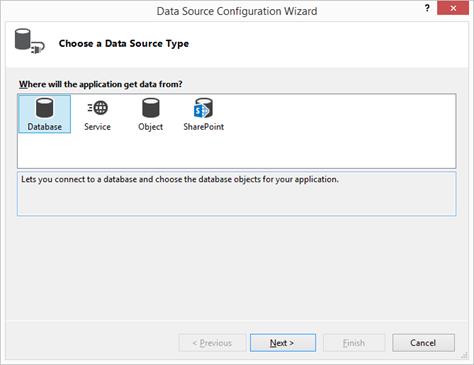
3) Select Database on the Choose a Data Source Type page, and then select Next.
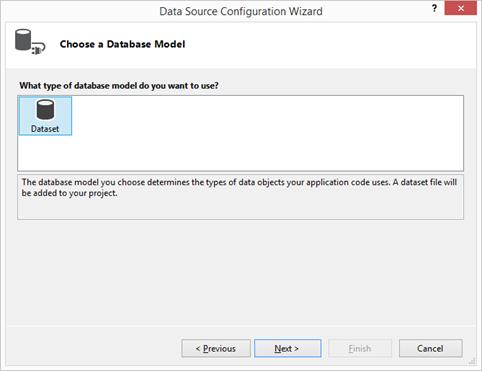
4) On the Choose your Data Connection page, select New Connection to configure a new data connection and Change the Data source to .NET Framework Data Provider for OLE DB.
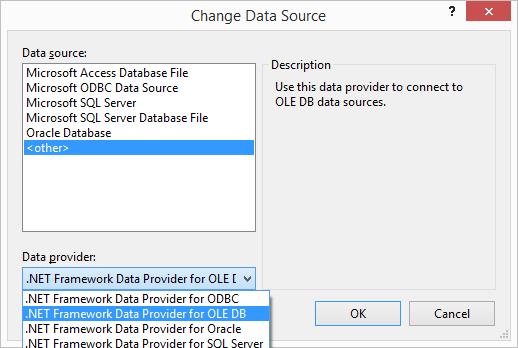
5) In OLE DB Provider, select Microsoft Office 12.0 Access Database Engine OLE DB Provider. In Server or file name, specify the path and name of the .accdb file to which want to connect, and then select OK.
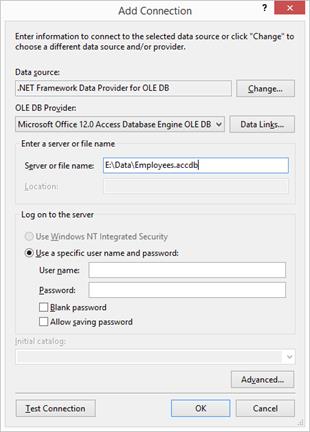
6) Select Next on the Choose your Data Connection page.
7) Select Next on the Save connection string to the Application Configuration file page.
8) Expand the Tables node on the Choose your Database Objects page.
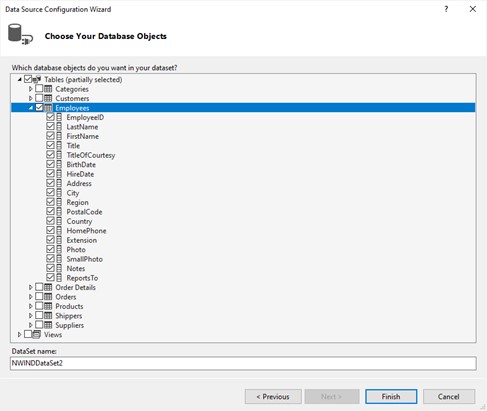
9) Select whatever tables or views in the dataset, and then select Finish.
Loading Data from Microsoft Access Database
To access the Microsoft Access database, follow the below steps.
1) The DataSource property can be customized at designer level like below,
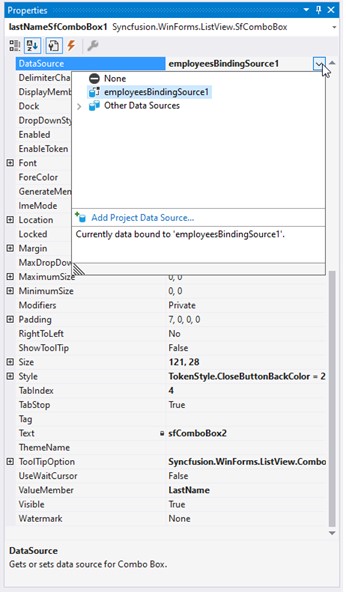
2) The value for DisplayMember and ValueMember properties can be selected as like below,
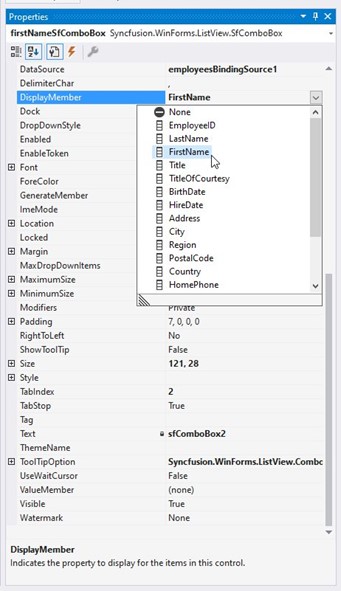
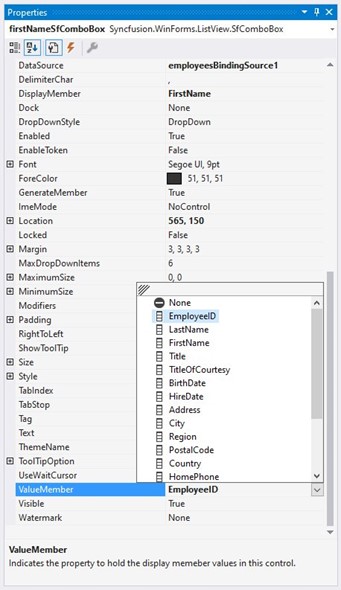
3) Based on the DataSource binding with the SfComboBox control, the items can be displayed by using DisplayMember and ValueMember properties.

Binding Data from LINQ to SQL
The SfComboBox control supports to bind data from LINQ to SQL. This walkthrough, describes about binding data from LINQ to SQL and save back the changes to the Database.
Adding Data Model using LINQ to SQL
To create data model using LINQ to SQL in WF project follow the below steps.
1) Right click on the project, Select Add option and then click New Item.
2) The Add New Item wizard appears, Select LINQ to SQL Classes from the Visual C#.
3) Name the file as Northwind and then select Add option to add the Northwind.dbml in the project.
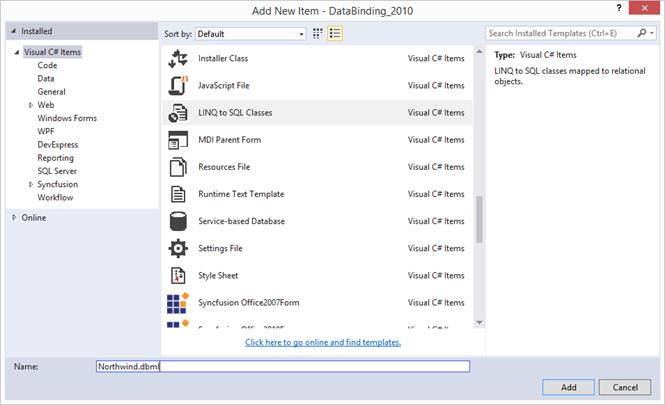
4) Once the Northwind.dbml is added in the project, then the design view is opened.
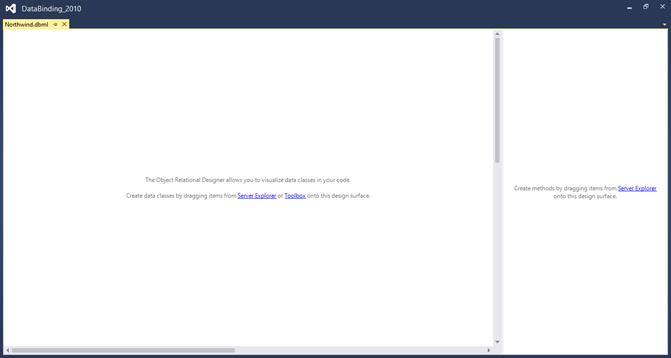
5) New Database connection can be added by clicking add icon button in Server Explorer.
6) The Add Connection wizard appeared with the default data source as Microsoft SQL Server Database File (SqlClient).

7) Click Change to open the Change Data Source dialog box and select the type of data source as Microsoft SQL Server Database File (SqlClient).
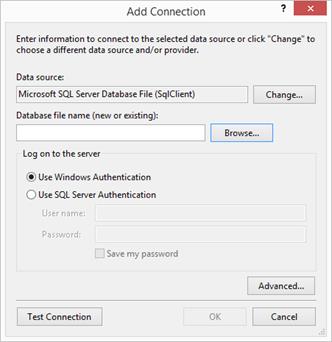
8) Select the Database file name and click on Test Connection to check the connection with the database.
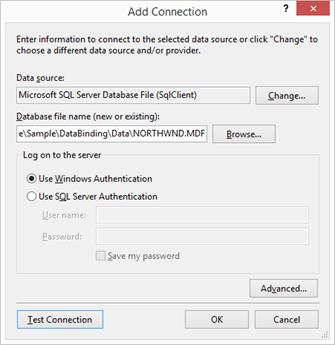
9) Once the connection is succeeded, click OK button to add database in the server explorer.
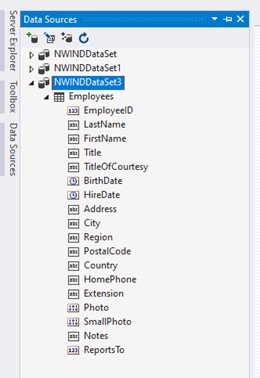
10) Drag Employees table in to design view of Northwind.dbml. The Entity model diagram for Employees table is generated once it is dropped in to design view.
Loading Data from LINQ to SQL Classes
The data from the defined data model of the LINQ to SQL classes can be loaded as a data source to the SfComboBox by loading the Employees table by the created data context for the Northwnd database.
1) The DataSource property can be customized at designer level like below,

2) The value for DisplayMember and ValueMember properties can be selected as like below,


3) Based on the DataSource binding with the SfComboBox control, the items can be displayed by using DisplayMember and ValueMember properties.
